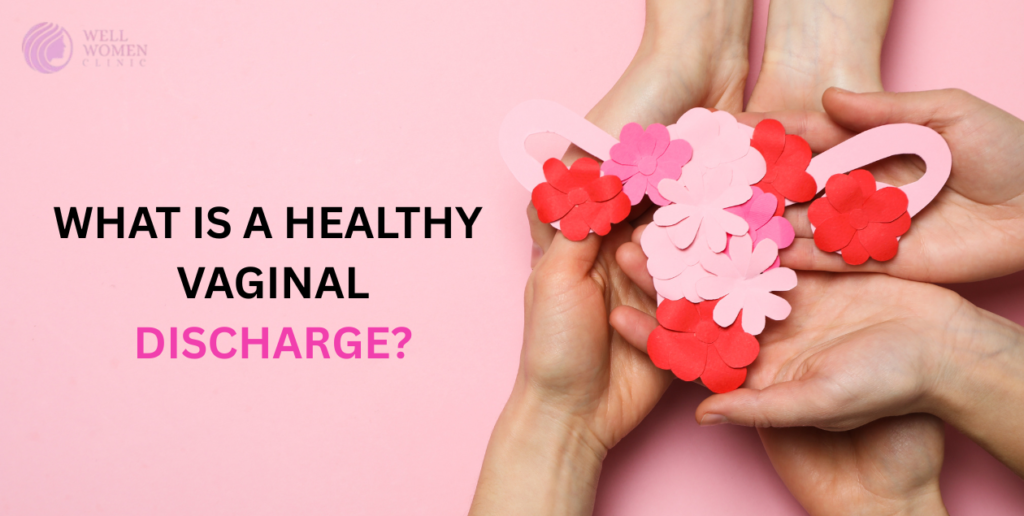This blog helps you understand what healthy vaginal discharge looks like, what changes are normal, and when it might signal a concern. It also shares simple tips on maintaining good vaginal hygiene and why being aware of your body’s natural patterns is essential for overall wellness.
For many women, vaginal discharge can feel like a mystery — sometimes it’s light, sometimes it’s heavier, and occasionally, it’s even alarming. The reality is that vaginal discharge is a natural and important function of the female reproductive system. Understanding what’s considered healthy versus what may signal a problem is key to taking control of your intimate health. So, let’s break the stigma and talk about what your body is naturally trying to tell you.
Understanding Vaginal Discharge
Vaginal discharge is a fluid produced by the glands located in the vagina and cervix. This fluid carries away dead cells and bacteria, helping to keep the vagina clean and free from infection. In short, discharge is your body’s way of maintaining balance and promoting good reproductive health. The amount, color, and consistency can vary throughout your menstrual cycle — and that’s completely natural.
Many women notice changes depending on where they are in their cycle. For example, during ovulation, discharge might become clear and stretchy — often compared to egg whites. Before or after a period, it may appear thicker or slightly off-white. All of this falls under the umbrella of normal vaginal discharge, and learning to recognize your own patterns is an important part of staying in tune with your body.
What Does Healthy Discharge Look Like?
Healthy vaginal discharge can look a bit different from person to person, but there are a few consistent signs to keep in mind:
- Color: Usually clear, white, or may appear slightly yellow when it comes into contact with air.
- Consistency: It can range from watery to slightly thick, depending on hormone levels and time of the month.
- Smell: Generally mild or has no noticeable odor. A strong, unpleasant, or fishy smell could be a sign of an imbalance or infection.
- Amount: Varies based on hormonal changes, stress, medication, or sexual activity.
It’s also worth noting that lifestyle factors — such as diet, hydration, and exercise — can influence the characteristics of your discharge. Pregnancy, breastfeeding, and contraceptive use may also cause noticeable shifts.
When Should You Be Concerned?
While many types of discharge are harmless, there are some signs that could indicate a health issue requiring medical attention. These include:
- A sudden increase in volume
- Green, grey, or cottage cheese-like texture
- Burning, itching, or irritation
- Pain during intercourse or urination
- A strong or unpleasant odor
Conditions such as bacterial vaginosis, yeast infections, or sexually transmitted infections (STIs) often present with abnormal discharge as a symptom. If you notice something out of the ordinary that persists for more than a few days, don’t ignore it. Listening to your body is the first step toward early intervention and care.
Hormones and Their Role in Discharge
The body’s hormonal landscape has a direct influence on discharge patterns. Estrogen and progesterone, the two primary female hormones, fluctuate throughout your menstrual cycle and play a pivotal role in changing the volume and texture of vaginal fluid.
For instance:
- Ovulation: Estrogen levels peak, making discharge clearer and stretchier — a natural signal of fertility.
- Luteal Phase (after ovulation): Progesterone rises, which may lead to thicker or cloudy discharge.
- Pregnancy: Hormonal changes can lead to increased white or milky vaginal discharge.
- Menopause: Reduced estrogen often results in decreased lubrication, making discharge minimal or absent.
Knowing these patterns not only demystifies the process but empowers women to anticipate changes and take action when something feels off.
Supporting Your Vaginal Health
Maintaining a healthy vaginal environment doesn’t require harsh products or excessive routines. In fact, over-washing or using scented feminine hygiene products can disrupt the natural pH and bacterial balance, leading to irritation or infections.
Instead, consider these simple tips:
- Opt for breathable underwear: Cotton is best for airflow and moisture control.
- Avoid douching: This can wash away beneficial bacteria and increase infection risk.
- Engage in safe sex: Using protection helps lower the risk of sexually transmitted infections (STIs).
- Stay hydrated and eat a balanced diet: What you consume affects your overall health, including vaginal health.
- Promote hormonal balance: Managing stress, getting restful sleep, and staying active all play a vital role.
Good vaginal hygiene starts with understanding what your body needs — not what the marketing industry tells you.
The Importance of Regular Checkups
Even when you feel perfectly healthy, routine gynecological exams are essential. Annual screenings can detect infections or irregularities early, even before symptoms appear. Your doctor can also help interpret any changes in discharge and provide tailored guidance based on your age, lifestyle, and medical history.
Discussing your symptoms — even ones that feel a bit embarrassing — helps in getting the right support. When it comes to your health, no question is ever too small or insignificant.
Normalizing the Conversation Around Discharge
For too long, conversations about vaginal discharge have been tucked away as taboo or “unladylike.” But acknowledging and talking openly about it can change that narrative. When women understand what’s happening in their bodies, they feel less anxious and more empowered to seek help when needed.
If you’re a parent or caregiver to a young girl, teaching her that discharge is part of growing up — not something to be ashamed of — can lay the foundation for a lifetime of confidence and bodily awareness.
Conclusion: Pay Attention to Your Body’s Signals
Vaginal discharge isn’t just “normal” — it’s necessary. It’s a living signal from your body, telling you what’s working, what’s changing, and when something might need your attention. Understanding the difference between what’s healthy and what’s not is the first step in embracing your reproductive health.
When in doubt, consult a qualified professional. There’s nothing embarrassing about asking questions or wanting clarity on how your body works. You have every right to feel knowledgeable, empowered, and supported in your health journey—every step of the way.
If you’re searching for a trusted gynaecologist specialist in London, Well Women Clinic provides expert care tailored to every phase of a woman’s life—from routine screenings to comprehensive vaginal health support. Take charge of your health with compassionate, professional guidance.





